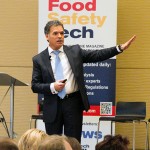In today’s fast-paced world, ensuring food safety and efficiency is crucial for food businesses. Fortunately, technological advancements, including the Internet of Things (IoT), have revolutionized the way the food industry operates. By leveraging IoT, food businesses can drive efficiency, enhance food safety, mitigate risks and boost transparency throughout the supply chain. All food businesses should be embracing IoT innovations to optimize their operations, improve efficiency, maximize safety and drive key performance indicators (KPIs), including consumer satisfaction, loyalty and sales.
The benefits of using IoT in the food industry include:
- Enhancing food safety. IoT enables real-time tracking and monitoring of food products throughout the supply chain. With the help of connected sensors and devices, businesses can monitor crucial variables including temperature and humidity to ensure optimal storage conditions. Both companies and consumers benefit from this heightened level of food safety and quality assurance.
- Improving supply chain transparency. IoT enhances end-to-end visibility and traceability. By employing sensors and radiofrequency identification (RFID) tags, businesses can track the movement of food products all along the supply chain, from farm to fork. This transparency helps identify the origin of any issues or recalls, significantly reducing the impact on public health. Moreover, it enables quicker and more targeted responses to any potential food safety breaches, mitigating risks, preventing foodborne illness outbreaks and ensuring consumer trust in the food supply chain.
- Optimizing shelf life for product inventory. IoT devices collect data on product conditions, such as temperature, humidity and light exposure. This information empowers businesses to optimize inventory management, implement dynamic pricing strategies and reduce waste (and associated costs) by ensuring products are sold or consumed before expiration. By minimizing food waste, companies contribute to sustainability efforts and consumers benefit from fresher and safer products.
- Upgrading real-time monitoring and predictive analytics. IoT devices provide real-time data on critical factors, including equipment performance, energy consumption and production processes. Businesses can detect patterns and predict potential issues by leveraging advanced analytics and machine learning algorithms. By identifying risks in advance, companies can proactively address them, preventing downtime and improving overall operational efficiency.
- Elevating the customer experience. IoT can also improve the customer experience. Smart shelves equipped with sensors, for example, can offer personalized recommendations, nutritional information and/or recipe suggestions based on customer preferences. Connected devices in restaurants or food delivery services can streamline the ordering process, improve order accuracy and provide real-time status updates, making the customer journey smoother and more convenient.
It’s clear that IoT offers significant benefits for food companies. Following are five important considerations as you investigate these innovative solutions:
- Assess your organization’s specific needs. Identify areas of your food business that can benefit from IoT technology. Consider cold chain management, quality control, inventory management and any other aspect of operations or supply chain that can be optimized. Define the specific goals you want to achieve through IoT implementation.
- Choose reliable technology. Select IoT devices and solutions that are reliable, scalable and aligned with your business requirements. Prioritize factors such as data security, interoperability, ease of integration and ongoing support. Ensure that the technology you choose meets industry standards and regulations. Work only with trusted tech vendors.
- Examine your data management and analytics processes. Develop a robust data management strategy to collect, store and analyze the vast amounts of data that will be generated by the IoT devices. Employ analytics tools to derive actionable insights from the data, and use these insights to make more informed decisions.
- Collaborate with the right partners. Explore partnerships with technology providers, industry associations and regulatory bodies to stay updated on emerging standards, best practices and compliance requirements related to IoT technologies in the food industry. Collaborating with experts and industry peers can accelerate your IoT implementation journey.
- Prioritize data security. Implement robust security measures to protect your IoT devices and the data they collect. This includes network security, encryption, authentication protocols and regular monitoring for potential vulnerabilities. Safeguarding data privacy and complying with regulations is vital in maintaining trust with customers and partners.
Avoiding IoT-driven technologies in the food industry is no longer an option. These devices have become necessary to drive efficiency, enhance food safety, meet regulatory requirements and consumers’ evolving expectations, and stay competitive. By leveraging IoT solutions, businesses can optimize their processes, improve transparency, reduce waste and provide exceptional customer experiences. However, successful implementation requires a strategic approach, careful planning, ongoing monitoring and continuous improvement. By prioritizing food safety and communication, and identifying areas of greatest need for improvement, the food industry can unlock the full potential of IoT technology and pave the way for a safer future.







